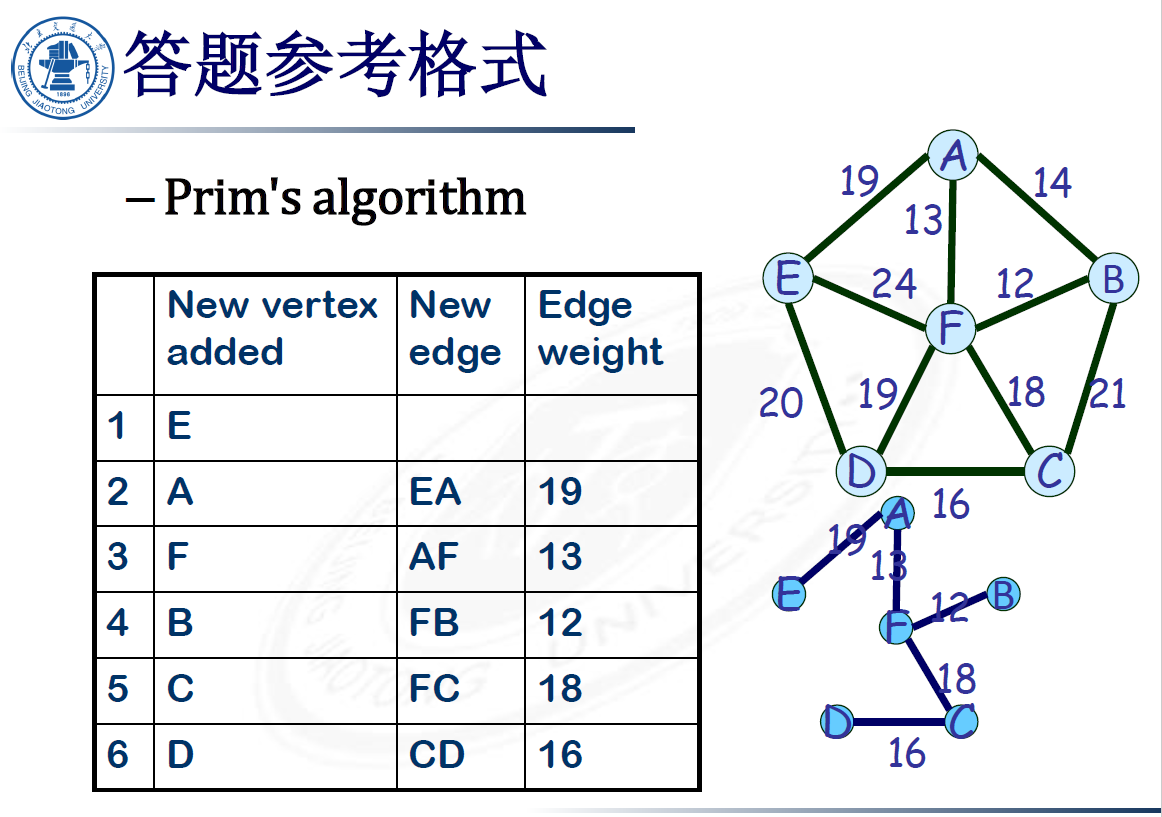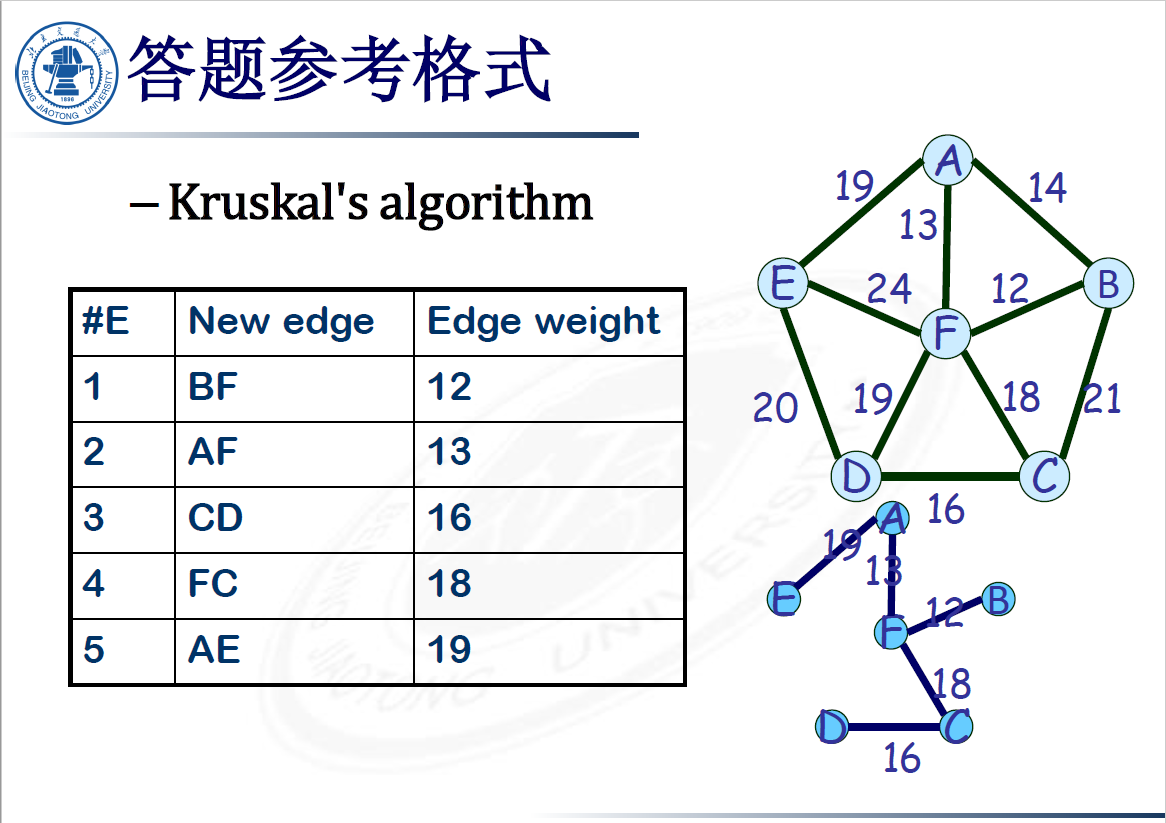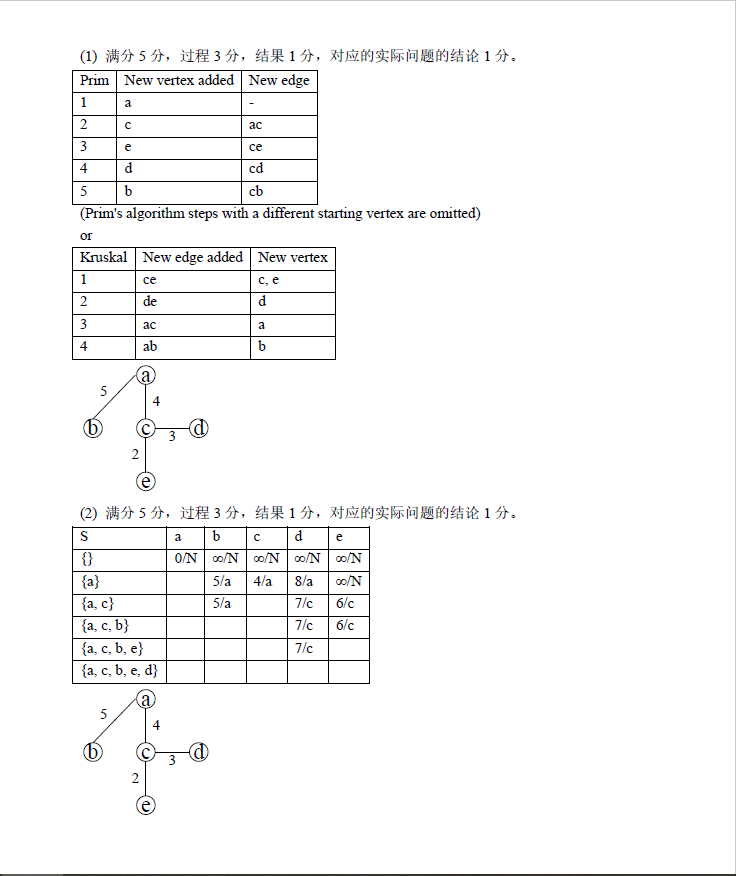@TangWill
2019-05-15T09:58:34.000000Z
字数 6214
阅读 790
Theorem and Algorithm
DiscreteMathematicalStructures
Theorem
Chapter 1
Theorem 1
If A,B and C are finite sets, then
Theorem 2
Theorem 3
If A, B, and C are Boolean matrices of compatible sizes, then
Chapter 2
key word:Tautology、Contradiction、Contingency
Theorem 1
Chapter 4
Theorem 1
If both A and B are finite sets then
Theorem 2
Let R and S be relations from A to B. If R(a)=S(a) for all a in A, then R=S.
Theorem 3
A relation R is transitive if and only if it satisfies the following property: If there is a path of length greater than 1 from vertex a to vertex b, there is a path of length 1 from a to b (that is, a is related to b). Algebraically stated, R is transitive if and only if for all .
Theorem 4
Let P be a partition of a set A. Recall that the sets in P are called the blocks of P . Define the relation R on A as follows:
aRb if and only if a and b are members of the same block.
Then R is an equivalence relation on A.
Theorem 5
Let R be an equivalence relation on A, and let P be the collection of all distinct relative sets R(a) for . Then P is a partition of A, and R is the equivalence relation determined by P .
Theorem 6
Suppose R and S are relations from A to B.
If ,then
If ,then
and
and
Theorem 7
Let R and S be relations of a set A.
If R is reflexive, so is .
If R and S are reflexive, then so are and .
R is reflexive if and only if is irreflexive.
Theorem 8
Let R be a relation on a set A. Then
R is symmetric if and only if .
R is antisymmetric if and only if .
R is asymmetric if and only if .
Theorem 9
R is reflexive if and only if .
R is irreflexive if and only if .
R is transitive if and only if .
R is transitive if and only if , for any .
Theorem 10
Let R and S be relations on A.
If R is symmetric, so are and R.
If R and S are symmetric, so are and .
Theorem 11
Let R and S be relations on A.
If R and S are transitive, so are .
If R and S are equivalence relations, so are .
| If R and S have the properties | S◦R | ||||
|---|---|---|---|---|---|
| Reflexive | Irreflexive | 1 | 1 | 1 | 1 |
| Irreflexive | Reflexive | 1 | 1 | 1 | 0 |
| Symmetric | 1 | 1 | 1 | 1 | 0 |
| Antisymmetric | 1 | 1 | 1 | 1 | 0 |
| Transitive | 0 | 1 | 1 | 0 | 0 |
| Equivalence | 0 | 1 | 1 | 0 | 0 |
Theorem 12
Let R be a relation from A to B, and let S is a relation from B to C. Then if is any subset of A, we have
Theorem 13
Suppose that A, B, C, and D are sets, R is a relation from A to B, S is a relation from B to C ,and T is a relation from C to D. Then
Theorem 14
Suppose that A, B and C are sets, R is a relation from A to B, and S is a relation from B to C. Then
Theorem 15
If R and S are equivalence relations on a set A, then the smallest equivalence relation containing both R and S is
Chapter 5
Theorem 1
Let f : be a function.
Then is a function from B to A if and only if f is one to one.
Let f : be a function. If is a function, then
the function f -1 is also one-to-one.
is everywhere defined if and only if f is onto.
is onto if and only if f is everywhere defined .
Theorem 2
Let f : be a function.
Theorem 3
If f : is a one-to-one correspondence between A and B, then
Theorem 4
Let f : and g : be functions such that g◦f =1_A$ and f◦g=1B. Then f is a one-to-one correspondence between A and B, g is a one-to-one correspondence between B and A, and each is the inverse of the other.
Let f : and g : be invertible. Then g◦f is invertible, and .
Chapter 6
Theorem 1
If and are posets, then is a poset, with the partial order defined by
if in A and in B
Theorem 2
Let A be a finite nonempty poset with partial order . Then A has at least one maximal element and at least one minimal element
Theorem 3
A poset has at most one greatest element and at most one least element.
Theorem 4
Let be a poset. Then a subset B of A has at most one LUB and at most one GLB.
Chapter 7
Theorem 1
Let be a rooted tree. Then
There are no cycles in T .
is the only root of T.
Theorem 2
Let R be a symmetric relation.
The following statements are equivalent.
(a) R is an undirected tree.
(b) R is connected and acyclic.
(c) R is acyclic, and if any undirected edge is added to R, the new relation will not be acyclic.
(d) R is connected, and if any undirected edge is removed from R, the new relation will not be connected.
Theorem 3
Let R be a symmetric relation on a set A, |A|=n is finite.
The following statements are equivalent.
(a) R is an undirected tree.
(b) R is connected and has n-1 edges.
(c) R is acyclic and has n-1 edges.
Chapter 8
Theorem 1
(a) A graph G has an Eulerian circuit if and only if G is connected and every vertex has even degree.
(b) A graph G has an Eulerian path if and only if either all, or all but two vertices, the two endpoints, have an even degree.
Theorem 2
simple graph with n vertices is Hamiltonian if each vertex has degree n/2 or greater
Theorem 3
A graph with n vertices is Hamiltonian if, for each pair of non-adjacent vertices, the sum of their degrees is n or greater .
Theorem 4
Let the number of edges of G be m. then G has a Hamiltonian circuit if .
Algorithm
Warshall's Algorithm
1.CLOSURE MAT
2.FOR K=1 THRU N
a. FOR I = 1 THRU N
1. FOR J = 1 THRU N
a. CLOSURE[I,J]CLOSURE[I,J] (CLOSURE[I,K] CLOSURE[K,J])
Warsheall算法直观应用
- 第k次
- 第k行不为0元素所在列画直线,
- 第k列不为0元素所在行画直线,
- 直线相交位置如果为0,则改为1
topology ordering Algorithm
For finding a topological sorting of a finite poset
Step 1 Choose a minimal element a of A
Step 2 Make a the next entry of SORT and replace A with A-{a}.
Step 3 Repeat steps 1 and 2 until A ={}
Prim’s Algorithm

Kruskal’s Algorithm

Dijkstra’s Algorithm
T(v) = min{ T(u)+|uv| } for all and u is adjacent to v.

Fleury's Algorithm
We start with a vertex of odd degree—if the graph has none, then start with any vertex.
At each step we move across an edge which is not a bridge, unless we have no choice, then we delete that edge.
At the end of the algorithm there are no edges left, and the sequence of edges we moved across forms an Eulerian circuit if the graph has no vertices of odd degree or an Eulerian path if there are two vertices of odd degree.
Welsh–Powell algorithm
order the vertices according to their degrees as and assigns to the smallest available color not used by neighbours among , adding a fresh color if needed.
